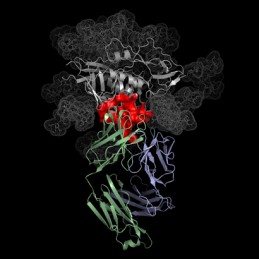Scientists Find Antibodies that Prevent Most HIV Strains from Infecting Human Cells
July 9, 2010

This image shows the atomic structure of the antibody VRC01 (blue and green) binding to HIV (grey and red). The precise site of VRC01-HIV binding (red) is a subset of the area of viral attachment to the primary immune cells HIV infects (NIAID VRC)
Two potent human antibodies that can stop more than 90 percent of known global HIV strains from infecting human cells in the laboratory have been discovered by scientists lead by a team from the NIH National Institute of Allergy and Infectious Diseases (NIAID) Vaccine Research Center.
According to the scientists, these antibodies could be used to design improved HIV vaccines, or could be further developed to prevent or treat HIV infection. Moreover, the method used to find these antibodies could be applied to isolate therapeutic antibodies for other infectious diseases as well.
The scientists found two naturally occurring, powerful antibodies called VRC01 and VRC02 in an HIV infected individual’s blood using a novel molecular device they developed that hones in on the specific cells that make antibodies against HIV. The device is an HIV protein that the scientists modified so it would react only with antibodies specific to the site where the virus binds to cells it infects.
They found that VRC01 and VRC02 neutralize more HIV strains with greater overall strength than previously known antibodies to the virus.
The researchers also determined the atomic-level structure of VRC01 when it is attaching to HIV. This has enabled the team to define how the antibody works and to precisely locate where it attaches to the virus. With this knowledge, they have begun to design components of a candidate vaccine that could teach the human immune system to make antibodies similar to VRC01 that might prevent infection by the vast majority of HIV strains worldwide.
Finding individual antibodies that can neutralize HIV strains anywhere in the world has been difficult because the virus continuously changes its surface proteins to evade recognition by the immune system. As a consequence of these changes, an enormous number of HIV variants exist worldwide. Even so, scientists have identified a few areas on HIV’s surface that remain nearly constant across all variants. One such area, located on the surface spikes used by HIV to attach to immune system cells and infect them, is called the CD4 binding site. VRC01 and VRC02 block HIV infection by attaching to the CD4 binding site, preventing the virus from latching onto immune cells.
“The antibodies attach to a virtually unchanging part of the virus, and this explains why they can neutralize such an extraordinary range of HIV strains,” says Dr. Mascola, the deputy director of the VRC.
The two research teams included NIAID scientists from the VRC, the Laboratory of Immunoregulation, and the Division of Clinical Research, all in Bethesda, Md.; as well as researchers from Beth Israel Deaconess Medical Center in Boston; Columbia University in New York; Harvard Medical School and Harvard School of Public Health in Boston; The Rockefeller University in New York City; and University of Washington in Seattle.
References:
Wu X et al. Rational design of envelope surface identifies broadly neutralizing human monoclonal antibodies to HIV-1. Science. DOI: 10.1126/science.1187659 (2010).
Zhou T et al. Structural basis for broad and potent neutralization of HIV-1 by antibody VRC01. Science. DOI: 10.1126/science.1192819 (2010).
More info: National Institute of Allergy and Infectious Diseases news